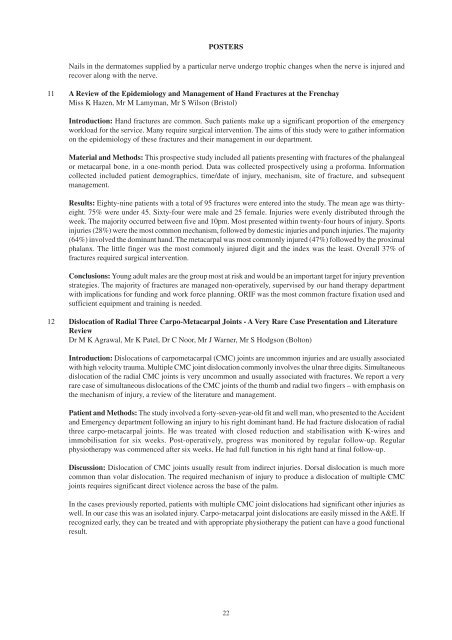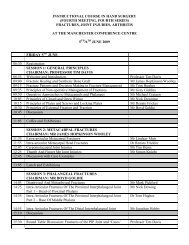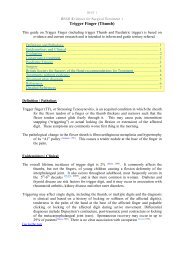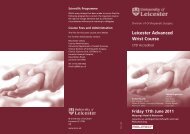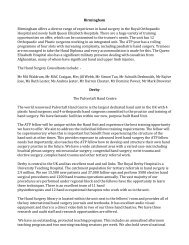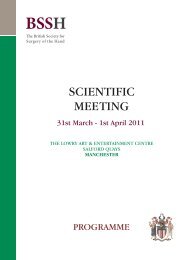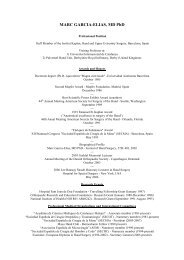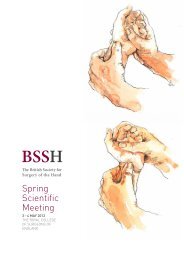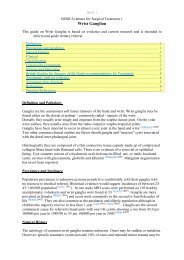here - The British Society for Surgery of the Hand
here - The British Society for Surgery of the Hand
here - The British Society for Surgery of the Hand
Create successful ePaper yourself
Turn your PDF publications into a flip-book with our unique Google optimized e-Paper software.
POSTERS<br />
Nails in <strong>the</strong> dermatomes supplied by a particular nerve undergo trophic changes when <strong>the</strong> nerve is injured and<br />
recover along with <strong>the</strong> nerve.<br />
11 A Review <strong>of</strong> <strong>the</strong> Epidemiology and Management <strong>of</strong> <strong>Hand</strong> Fractures at <strong>the</strong> Frenchay<br />
Miss K Hazen, Mr M Lamyman, Mr S Wilson (Bristol)<br />
Introduction: <strong>Hand</strong> fractures are common. Such patients make up a significant proportion <strong>of</strong> <strong>the</strong> emergency<br />
workload <strong>for</strong> <strong>the</strong> service. Many require surgical intervention. <strong>The</strong> aims <strong>of</strong> this study were to ga<strong>the</strong>r in<strong>for</strong>mation<br />
on <strong>the</strong> epidemiology <strong>of</strong> <strong>the</strong>se fractures and <strong>the</strong>ir management in our department.<br />
Material and Methods: This prospective study included all patients presenting with fractures <strong>of</strong> <strong>the</strong> phalangeal<br />
or metacarpal bone, in a one-month period. Data was collected prospectively using a pro<strong>for</strong>ma. In<strong>for</strong>mation<br />
collected included patient demographics, time/date <strong>of</strong> injury, mechanism, site <strong>of</strong> fracture, and subsequent<br />
management.<br />
Results: Eighty-nine patients with a total <strong>of</strong> 95 fractures were entered into <strong>the</strong> study. <strong>The</strong> mean age was thirtyeight.<br />
75% were under 45. Sixty-four were male and 25 female. Injuries were evenly distributed through <strong>the</strong><br />
week. <strong>The</strong> majority occurred between five and 10pm. Most presented within twenty-four hours <strong>of</strong> injury. Sports<br />
injuries (28%) were <strong>the</strong> most common mechanism, followed by domestic injuries and punch injuries. <strong>The</strong> majority<br />
(64%) involved <strong>the</strong> dominant hand. <strong>The</strong> metacarpal was most commonly injured (47%) followed by <strong>the</strong> proximal<br />
phalanx. <strong>The</strong> little finger was <strong>the</strong> most commonly injured digit and <strong>the</strong> index was <strong>the</strong> least. Overall 37% <strong>of</strong><br />
fractures required surgical intervention.<br />
Conclusions: Young adult males are <strong>the</strong> group most at risk and would be an important target <strong>for</strong> injury prevention<br />
strategies. <strong>The</strong> majority <strong>of</strong> fractures are managed non-operatively, supervised by our hand <strong>the</strong>rapy department<br />
with implications <strong>for</strong> funding and work <strong>for</strong>ce planning. ORIF was <strong>the</strong> most common fracture fixation used and<br />
sufficient equipment and training is needed.<br />
12 Dislocation <strong>of</strong> Radial Three Carpo-Metacarpal Joints - A Very Rare Case Presentation and Literature<br />
Review<br />
Dr M K Agrawal, Mr K Patel, Dr C Noor, Mr J Warner, Mr S Hodgson (Bolton)<br />
Introduction: Dislocations <strong>of</strong> carpometacarpal (CMC) joints are uncommon injuries and are usually associated<br />
with high velocity trauma. Multiple CMC joint dislocation commonly involves <strong>the</strong> ulnar three digits. Simultaneous<br />
dislocation <strong>of</strong> <strong>the</strong> radial CMC joints is very uncommon and usually associated with fractures. We report a very<br />
rare case <strong>of</strong> simultaneous dislocations <strong>of</strong> <strong>the</strong> CMC joints <strong>of</strong> <strong>the</strong> thumb and radial two fingers – with emphasis on<br />
<strong>the</strong> mechanism <strong>of</strong> injury, a review <strong>of</strong> <strong>the</strong> literature and management.<br />
Patient and Methods: <strong>The</strong> study involved a <strong>for</strong>ty-seven-year-old fit and well man, who presented to <strong>the</strong> Accident<br />
and Emergency department following an injury to his right dominant hand. He had fracture dislocation <strong>of</strong> radial<br />
three carpo-metacarpal joints. He was treated with closed reduction and stabilisation with K-wires and<br />
immobilisation <strong>for</strong> six weeks. Post-operatively, progress was monitored by regular follow-up. Regular<br />
physio<strong>the</strong>rapy was commenced after six weeks. He had full function in his right hand at final follow-up.<br />
Discussion: Dislocation <strong>of</strong> CMC joints usually result from indirect injuries. Dorsal dislocation is much more<br />
common than volar dislocation. <strong>The</strong> required mechanism <strong>of</strong> injury to produce a dislocation <strong>of</strong> multiple CMC<br />
joints requires significant direct violence across <strong>the</strong> base <strong>of</strong> <strong>the</strong> palm.<br />
In <strong>the</strong> cases previously reported, patients with multiple CMC joint dislocations had significant o<strong>the</strong>r injuries as<br />
well. In our case this was an isolated injury. Carpo-metacarpal joint dislocations are easily missed in <strong>the</strong> A&E. If<br />
recognized early, <strong>the</strong>y can be treated and with appropriate physio<strong>the</strong>rapy <strong>the</strong> patient can have a good functional<br />
result.<br />
22


